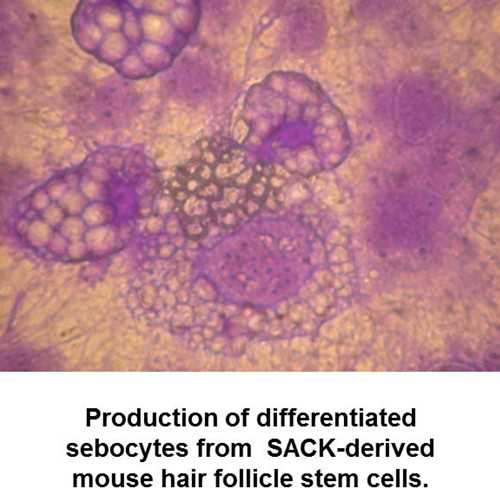SACK-Xn 3C5 Adult Mouse Hair Follicle Stem Cells
Growing and expanding primary, differentiated adult cells in culture is difficult and laborious because many differentiated cells can only be maintained in vitro for a limited period of time. However, for controlled experiments, it may be necessary to maintain a consistent population of cells.
Maintaining a population of adult stem cells (ASCs), allows one to exponentially propagate a population of cells in vitro, and induce differentiation when desired. This is possible with SACK cell strains and specified cell culture conditions.
SACK ASC cell properties – Long-term propagation in xanthine (Xn)-supplemented medium
- Suppressed asymmetric cell kinetics
- Express the epithelial stem cell biomarker LGR-5
- Xn-suppressed non-random sister chromatid segregation
Differentiated progeny cell properties – Xn-free medium, confluent monolayer, serum reduction
- Sebocyte differentiation as well as other undefined cell types
- Induced expression of K5, K10, and filaggrin
*Additional similar, but less well characterized, independent clonal cell strains are available. For more information, contact us.
Growing and expanding primary, differentiated adult cells in culture is difficult and laborious because many differentiated cells can only be maintained in vitro for a limited period of time. However, for controlled experiments, it may be necessary to maintain a consistent population of cells.
Maintaining a population of adult stem cells (ASCs), allows one to exponentially propagate a population of cells in vitro, and induce differentiation when desired. This is possible with SACK cell strains and specified cell culture conditions.
SACK ASC cell properties – Long-term propagation in xanthine (Xn)-supplemented medium
- Suppressed asymmetric cell kinetics
- Express the epithelial stem cell biomarker LGR-5
- Xn-suppressed non-random sister chromatid segregation
Differentiated progeny cell properties – Xn-free medium, confluent monolayer, serum reduction
- Sebocyte differentiation as well as other undefined cell types
- Induced expression of K5, K10, and filaggrin
*Additional similar, but less well characterized, independent clonal cell strains are available. For more information, contact us.
| Product Type: | Cell Line |
| Name: | SACK-Xn 3C5 |
| Cell Type: | adult mouse hair follicle stem cells |
| Accession ID: | CVCL_5L00 |
| Organism: | mouse |
| Source: | whisker hair follicles of adult male FVB/NTac mice |
| Morphology: | epitheliod |
| Biosafety Level: | Bsl-1 |
| Subculturing: | Passage 1:5 when cells reach approx. 80% confluence |
| Growth Conditions: | SACK medium - DMEM (4.5mg/ml high glucose) w/ 10% dialyzed FBS and 400?M Xanthine |
| Cryopreservation: | 70% DMEM (high glucose); 20% dialyzed FBS; 10% DMSO |
| Storage: | Liquid nitrogen |
| Shipped: | Dry ice |
Replacement of the SACK medium with differentiation conditions allows the expanded tissue stem cells to regain their in vivo homeostatic state of asymmetric self-renewal, which yields cells committed to tissue-specific differentiation.
- Huh YH, Sherley JL. Decreased H3K27 and H3K4 trimethylation on mortal chromosomes in distributed stem cells. Cell Death Dis. 2014 Dec 4;5:e1554. doi: 10.1038/cddis.2014.522.
- Huh YH, King J, Cohen J, Sherley JL. SACK-Expanded Hair Follicle Stem Cells Display Asymmetric Nuclear Lgr5 Expression With Non-Random Sister Chromatid Segregation. Scientific Reports. 2011. View Article
- Sherley, J. L. and King, J. (2010) Methods for ex vivo propagation of somatic hair follicle stem cells. Patent No. US 7,655,465 B2.
- Jaks et al. (2008) Lgr5 marks cycling, yet long-lived, hair follicle stem cells. Nature Gen. 40, 1291-1299.
- Paré, J.-F. and Sherley, J. L. (2006) Biological principles for ex vivo adult stem cell expansion, in Curr. Top. in Devel. Biol., ed. G. Schatten, Elsevier, Inc. (San Diego), Vol. 73, pp. 141-171.
- Rambhatla et al.(2005) Immortal DNA strand cosegregation requires p53/IMPDH-dependentasymmetric self-renewal associated with adult stem cells. Cancer Res. 65, 3155-3161.
- Xia, et al. (1989) Isolation of human sebaceous glands and cultivationof sebaceous gland-derived cells in an in vitro model. J. Invest. Dermatol. 93, 315-321.
If you publish research with this product, please let us know so we can cite your paper.


